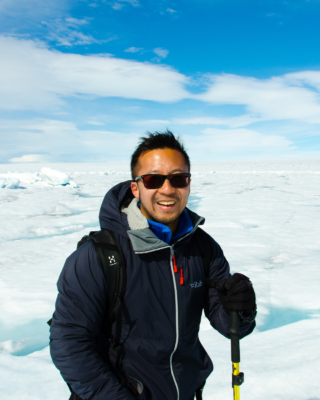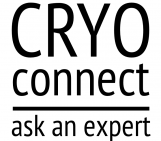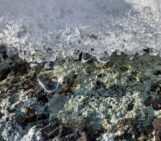
Every two years, the Cryospheric Sciences division of the European Geophysical Union (EGU) elects a new representative for its early-career scientists. Starting in April 2021, Tun Jan (TJ) Young will take over the role from Jenny Turton, who is the outgoing representative. TJ shares a bit about himself and how his previous leadership experience aligns with the goals of EGU’s early career scientists as well as the goals of its Cryospheric Sciences division.
Tell us a little bit about yourself!
Hi! I’m TJ Young, and I will be your early career scientist (ECS) representative for the Cryospheric Sciences (CR) division of the European Geosciences Union (EGU).
… Are you ready for more acronyms?
I am currently a postdoc based at the Scott Polar Research Institute (SPRI), University of Cambridge. For my research, I implement innovative radar methods to help improve our understanding of the dynamic behaviour of ice sheets. Specifically, I am most excited about radar polarimetry and how it can measure hidden properties of ice, such as its “fabric” (anisotropy) and its composition. My research forms part of the Thwaites Interdisciplinary Margin Evolution (TIME) project, one of eight different projects that form the International Thwaites Glacier collaboration (ITGC) that involves hundreds of scientists from institutions based primarily in the USA and UK.
But you’re not European!
You are correct, I am originally from Taipei, Taiwan. I grew up all over the world, including Hong Kong, Tokyo, Shanghai, and Durham (in the United States). In 2012, I began my postgraduate studies at the University of Cambridge, and barring a period of national service, have been here ever since. Although EGU represents Europe’s leading geosciences organisation, it welcomes membership and participation at all levels from all countries. As virtual meetings have become the norm over the past year, most of us are used to online intercontinental exchanges, which further highlights the importance of inclusion on a global (rather than limited to within Europe) scale.
Personally, I’d like to think that the international diversity of the EGU membership not only improves the EGU leadership, but also elevates the level of collaborative research presented at its national conference. More broadly, I hold the values of “JEDI” (justice, equity, diversity, and inclusion) quite close to my heart, and like Jenny, I hope to further position EGU’s early career scientists as a leading voice in these four values. I want to help shape the format of EGU as well as its outward-facing leadership to not only depict diversity, but to furthermore foster an inclusive and welcome space regardless of background and position. Diversity comes in many forms, including gender, sexual orientation, culture, ethnicity, career level, disability, and socioeconomics. Within the cryospheric research community, we are fortunate to have active societies that champion many of these values, such as the Association of Polar Early Career Scientists (@Polar_Research), Women in Polar Science (@WomeninPolarSci), Pride in Polar Research (@PridePolar), and Polar Impact (@PolarImpact). As well as being examples of successful initiatives, I aim to incorporate some of their ideas within EGU’s own cryospheric section through collaboration.
I’ll go follow these societies on Twitter right away! Are there any other issues you would like to focus on?
Unfortunately my secondary focus point is less exciting (but equally important!). I would like to focus on improving dialogue between different components within the EGU-verse. For example, did you know that we have individual division officers for topics such as sea ice, permafrost, snow, glaciers, ice sheets, ice caps, and ice shelves? I only found out about this last month! Separately, within our section, we also have separate committees for awarding medals and outstanding student presentations (OSPs). It’s obvious that the Cryosphere ECS committee can assist in each of these communities, and I hope to achieve a multilateral exchange of information across the entire Cryosphere division structure. In this way, our cryo-division can better serve and represent our early career members through increased transparency in its scientific governance.
How do we know that you have what it takes for this role?
From experience, I discovered that the quality of my research output declines if I don’t actively engage in other parallel activities. So, to counteract this unfortunate limitation, I have always been active in leadership, science communication and extracurricular activities. During my PhD, I was the president for the UK Polar Network (UKPN), as well as sitting on the executive council of its parent organisation, the Association for Polar Early Career Scientists. Through these organisations, I was involved in outward reaching activities at multiple scales, from conducting experiments to schoolchildren to coordinating the Antarctic Flags project, one of the UKPN’s “flagship” activities that involves students, teachers, and researchers all over the world. Currently, I sit on the American Geophysical Union (AGU)’s Meetings Committee as well as being a founding member of its Indigenous Action Subcommittee.

Our team (Mass2Ant) bringing the Antarctic Flags project to the Roi Baudouin Ice Shelf! Credits: TJ Young.
Does this mean that you have a conflict of interest? Are you a spy!?
On the contrary! In fact, I am able to draw my experiences from my involvement with AGU to help champion further inclusion of ECS across the EGU Leadership. Similarly, my work with AGU’s Indigenous Action Subcommittee gives me prior understanding of how to effectively implement broader JEDI values at the organisation level. I suspect the benefit works both ways: I can also bring successful aspects of the EGU leadership to AGU.
Sounds like you will be busy! Do you have help?
Of course I do! The cryo team is proudly one of EGU’s largest and most active. Within our team, we have two chief editors as well as many regular editors and authors for our award-winning weekly blogs. Our social media team manages our very active Twitter account (@EGU_CR) as well as our Facebook page (@egucryosphere). Lastly, we also rely on our early-career members to help organise short courses, convene scientific sessions, and other activities.
There is always more work to be done, and we always welcome new members to join our fun and active team! From past experience, getting involved in academic networks such as our division is one of the best way to expand your growing network as well as having further access to exciting opportunities. Please get in touch with me if you’d like to be part of our friendly family!
And do we have to say farewell to Jenny?
We can’t get rid of Jenny that easily, nor do we want to! When I officially take over our division’s ECR role, Jenny will begin her role as the Union-level ECS representative. For the first year, Jenny will be the deputy union-level ECS representative whilst she shadows Anita Di Chiara, before becoming the Union-level representative in 2022. As part of this role, she will voice the needs and suggestions of the division ECS representatives to the council level and communicate the decision and strategies to the representatives and EGU members.
How can I get in touch with you for more information?
You’re more than welcome to contact me via email (ecs-cr@egu.eu) or via Twitter (@tjy511). You can always find me during the next General Assembly (#vEGU21) at one of our organised Cryosphere section events. Otherwise, I recommend that you give our Cryo Twitter account a follow (@EGU_CR), as this is the easiest way to keep updated of social events and relevant dates for the upcoming conference as well as new blog posts!
Lastly, any fun facts about yourself?
After my PhD, I stepped away from academia for two years to complete mandatory conscription in Taiwan. A reminder that EGU’s definition of an early career scientist accounts for career breaks such as parental leave, personal illness, and national service!
As part of my national service, I was a park ranger for Taiwan’s Taroko National Park. It’s one of the most beautiful places in the world, and has amazing sightseeing and hiking opportunities. At its highest elevations of over 3500 m, it snows regularly and even has wonderful geomorphological landforms that show past glaciation!

Coming down the scree to Nanhu Cabin, with Mt. Nanhu (南湖大山) towering over the lower cirque. Credits: TJ Young.
Edited by Jenny Turton and Giovanni Baccolo




